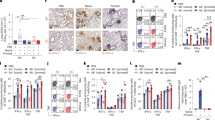Abstract
The hemolysin oligomer promotes the proliferation of B-1a cells and the expression of CD25, which is indicative of cell activation, on B-1a cells. The upregulation of CD86 induced by the oligomer showed its selective bias for the B7-2 member of B7 family while the monomer failed to induce these effects. The oligomer induced the expression of CXCR3, associated with B cell activation, while the monomer induced the expression of CXCL4, a powerful angiostatic chemokine. In conclusion, we found that B-1a cells responded to the apoptogenic monomer by expressing CXCL4, whereas oligomerization of the immunogen induced CXCR3 to shift the response towards activation.
This is a preview of subscription content, access via your institution
Access options
Subscribe to this journal
Receive 12 digital issues and online access to articles
$119.00 per year
only $9.92 per issue
Buy this article
- Purchase on Springer Link
- Instant access to full article PDF
Prices may be subject to local taxes which are calculated during checkout
Similar content being viewed by others
Author information
Authors and Affiliations
Corresponding author
Rights and permissions
About this article
Cite this article
Mukherjee, G., Banerjee, K. & Biswas, T. Oligomerization of Vibrio Cholerae Hemolysin Induces CXCR3 Upregulation and Activation of B-1a Cell. Cell Mol Immunol 5, 231–234 (2008). https://doi.org/10.1038/cmi.2008.29
Received:
Accepted:
Issue Date:
DOI: https://doi.org/10.1038/cmi.2008.29



